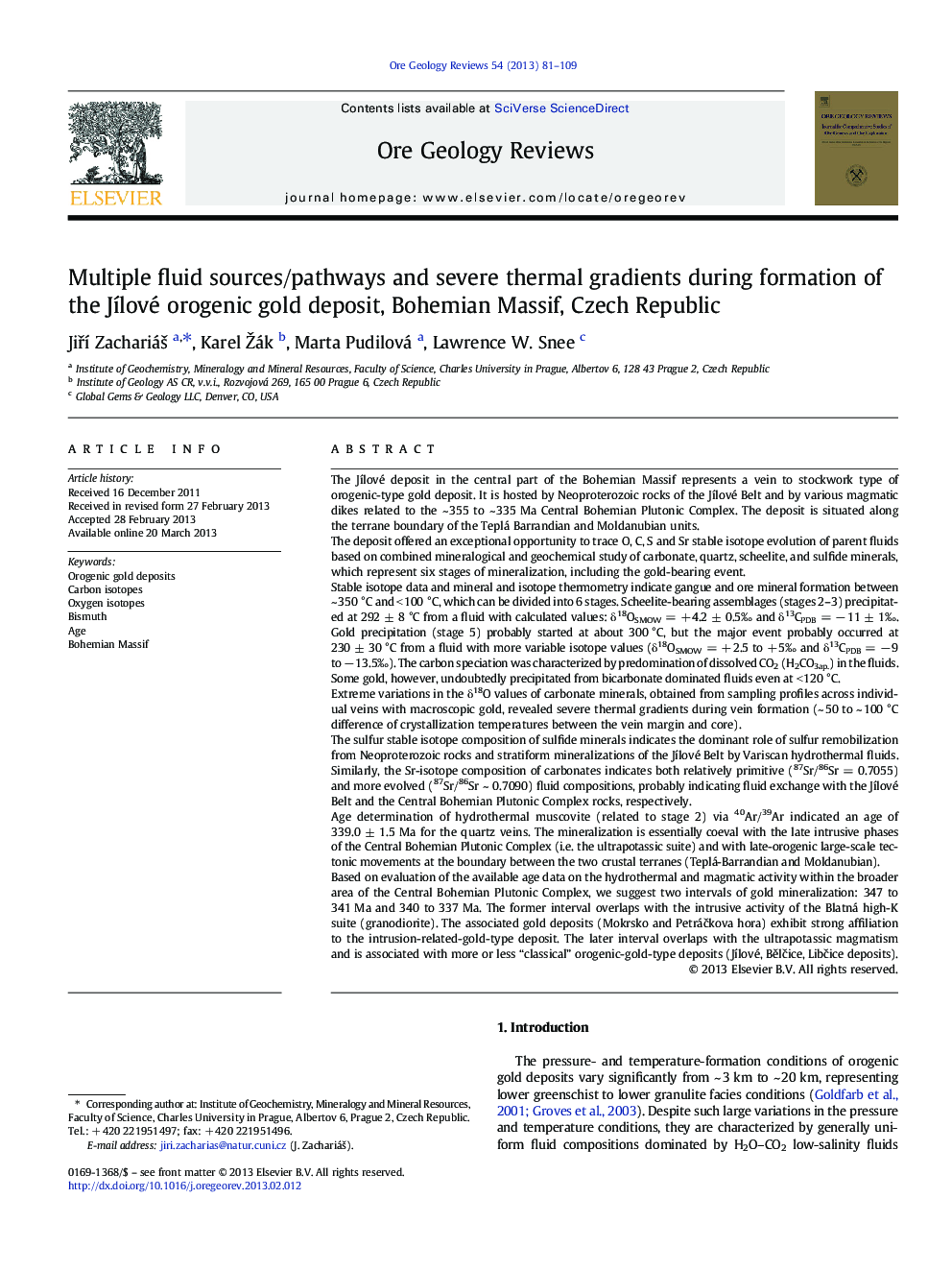| کد مقاله | کد نشریه | سال انتشار | مقاله انگلیسی | نسخه تمام متن |
|---|---|---|---|---|
| 4697463 | 1637249 | 2013 | 29 صفحه PDF | دانلود رایگان |

• Extreme variations in O-isotope composition of hydrothermal carbonate minerals
• Severe thermal gradients during gold precipitation
• Geochemical indication for changes in pathways of mineralizing fluids
• Ar/Ar dating of hydrothermal muscovite
• Evolution of Variscan hydrothermal gold mineralization
The Jílové deposit in the central part of the Bohemian Massif represents a vein to stockwork type of orogenic-type gold deposit. It is hosted by Neoproterozoic rocks of the Jílové Belt and by various magmatic dikes related to the ~ 355 to ~ 335 Ma Central Bohemian Plutonic Complex. The deposit is situated along the terrane boundary of the Teplá Barrandian and Moldanubian units.The deposit offered an exceptional opportunity to trace O, C, S and Sr stable isotope evolution of parent fluids based on combined mineralogical and geochemical study of carbonate, quartz, scheelite, and sulfide minerals, which represent six stages of mineralization, including the gold-bearing event.Stable isotope data and mineral and isotope thermometry indicate gangue and ore mineral formation between ~ 350 °C and < 100 °C, which can be divided into 6 stages. Scheelite-bearing assemblages (stages 2–3) precipitated at 292 ± 8 °C from a fluid with calculated values: δ18OSMOW = + 4.2 ± 0.5‰ and δ13CPDB = − 11 ± 1‰. Gold precipitation (stage 5) probably started at about 300 °C, but the major event probably occurred at 230 ± 30 °C from a fluid with more variable isotope values (δ18OSMOW = + 2.5 to + 5‰ and δ13CPDB = − 9 to − 13.5‰). The carbon speciation was characterized by predomination of dissolved CO2 (H2CO3ap.) in the fluids. Some gold, however, undoubtedly precipitated from bicarbonate dominated fluids even at < 120 °C.Extreme variations in the δ18O values of carbonate minerals, obtained from sampling profiles across individual veins with macroscopic gold, revealed severe thermal gradients during vein formation (~ 50 to ~ 100 °C difference of crystallization temperatures between the vein margin and core).The sulfur stable isotope composition of sulfide minerals indicates the dominant role of sulfur remobilization from Neoproterozoic rocks and stratiform mineralizations of the Jílové Belt by Variscan hydrothermal fluids. Similarly, the Sr-isotope composition of carbonates indicates both relatively primitive (87Sr/86Sr = 0.7055) and more evolved (87Sr/86Sr ~ 0.7090) fluid compositions, probably indicating fluid exchange with the Jílové Belt and the Central Bohemian Plutonic Complex rocks, respectively.Age determination of hydrothermal muscovite (related to stage 2) via 40Ar/39Ar indicated an age of 339.0 ± 1.5 Ma for the quartz veins. The mineralization is essentially coeval with the late intrusive phases of the Central Bohemian Plutonic Complex (i.e. the ultrapotassic suite) and with late-orogenic large-scale tectonic movements at the boundary between the two crustal terranes (Teplá-Barrandian and Moldanubian).Based on evaluation of the available age data on the hydrothermal and magmatic activity within the broader area of the Central Bohemian Plutonic Complex, we suggest two intervals of gold mineralization: 347 to 341 Ma and 340 to 337 Ma. The former interval overlaps with the intrusive activity of the Blatná high-K suite (granodiorite). The associated gold deposits (Mokrsko and Petráčkova hora) exhibit strong affiliation to the intrusion-related-gold-type deposit. The later interval overlaps with the ultrapotassic magmatism and is associated with more or less “classical” orogenic-gold-type deposits (Jílové, Bělčice, Libčice deposits).
Journal: Ore Geology Reviews - Volume 54, October 2013, Pages 81–109